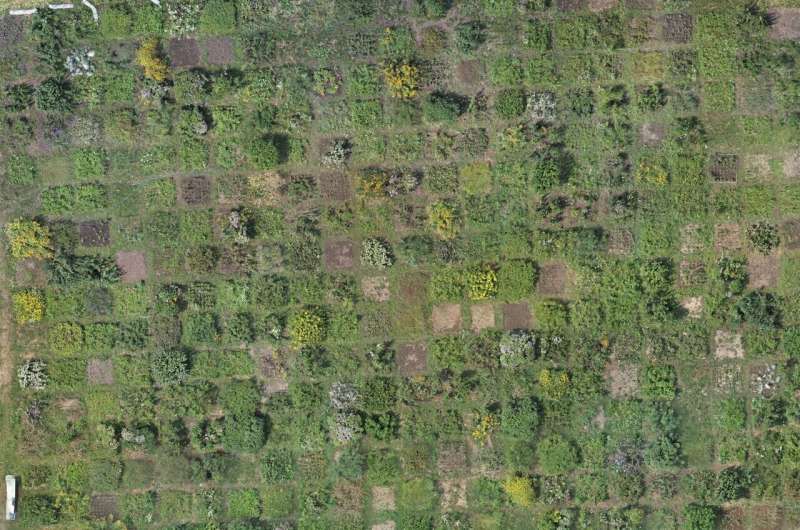
Remote sensing technology has become a vital tool for scientists over the past several decades for monitoring changes in land use, ice cover, and vegetation across the globe. Satellite imagery, however, is typically available at only coarse resolutions, allowing only for the analysis of broad trends over large areas. Remote-controlled drones are an increasingly affordable alternative for researchers working at finer scales in ecology and agriculture, but the laser-based technology used to estimate plant productivity and biomass, such as light detection and ranging (LiDAR), remain prohibitively expensive.
In research presented in a recently published issue of Applications in Plant Sciences, researchers used low-cost remote sensing technology to produce multispectral vegetation indices and 3-D photomosaics of the vegetation in a tallgrass prairie, comparing aerial estimates of biomass with direct measurements taken in the field. Based on their results, photogrammetry is a reliable way to estimate biomass, landcover, and ecosystem productivity, with several potential cost-saving implications for conservation and agricultural science.
Researchers carried out remote sensing data collection on a tallgrass prairie restoration experiment at the Morton Arboretum in Lisle, Illinois.
"The restoration experiment is designed to determine whether or not phylogenetic diversity and functional diversity affect restoration outcomes," said senior author Andrew Hipp, the Plant Systematist and Herbarium Director at the Morton Arboretum.
To accomplish this goal, Hipp and his research team drew from a total of 127 prairie species, each of which was planted as a monoculture in 4 m2 plots. These species were also mixed in various combinations in multispecies plots of the same size, ranging from high, medium, and low phylogenetic diversity crossed with high and low trait diversity.
Lead author Lane Scher, a community ecologist at Duke University, saw the experiment's design as a unique opportunity to test the precision of photogrammetry-based estimates of biomass between monocultures and multispecies plots.
The researchers used a DJI Phantom 4 drone equipped with a standard camera as well as a multispectral sensor that would allow them to calculate various vegetation indices—metrics based on ratios of light wavelengths that indicate the relative health and productivity of plant ecosystems.
By stitching together close to 600 overlapping images, the researchers created a set of mosaics of the study site, allowing them to calculate the height of the vegetation in each plot. By extrapolation, they were then able to estimate the total biomass of the tallgrass species.
Analytical comparisons made between the aerial- and field-based measurements indicate that estimates of biomass derived from photogrammetry explained up to 47% of the variation in biomass for multispecies plots, a fairly significant result that shows promise for this method.
"Of the metrics we used, volume was the best predictor of productivity, which is great news, because it's also the least expensive to measure," said Scher. Although the researchers used a multispectral sensor to obtain imagery for different wavelengths of light to calculate vegetation indices, their results suggest that a simple RGB camera is all that's needed to reliably estimate biomass.
These methods might not be as applicable to monocultures, however. The explanatory power of their model, which accounted for 47% of the variation in multispecies plots, dropped to 34% in monocultures, a trend that wasn't entirely unexpected by the team.
"In monocultures, you typically have only one layer of vegetation," said Scher. Plants of the same species and variety typically have the same growth form, with the result that most of the leaves compete for space in a single, crowded layer.
"In multispecies plots, however, vegetation can be more evenly spaced vertically," said Scher. Since 3-D photogrammetry calculates volume as everything between the soil surface and the top layer of vegetation, plots with plants evenly distributed in height will likely give the most accurate estimates.
While future comparisons with similar LiDAR measurements will be useful in further constraining the accuracy of photogrammetry for the estimation of biomass, the present study outlines a simple, fast, and affordable method to reliably assess vegetation productivity at fine-scale resolutions across large study areas.
Explore further
Provided by Botanical Society of America
Citation: Drone-based photogrammetry: A reliable and low-cost method for estimating plant biomass (2021, February 12) retrieved 12 February 2021 from https://ift.tt/3tKq3ye
This document is subject to copyright. Apart from any fair dealing for the purpose of private study or research, no part may be reproduced without the written permission. The content is provided for information purposes only.
"low" - Google News
February 12, 2021 at 03:58PM
https://ift.tt/3tKq3ye
Drone-based photogrammetry: A reliable and low-cost method for estimating plant biomass - Phys.org
"low" - Google News
https://ift.tt/2z1WHDx
Bagikan Berita Ini














0 Response to "Drone-based photogrammetry: A reliable and low-cost method for estimating plant biomass - Phys.org"
Post a Comment